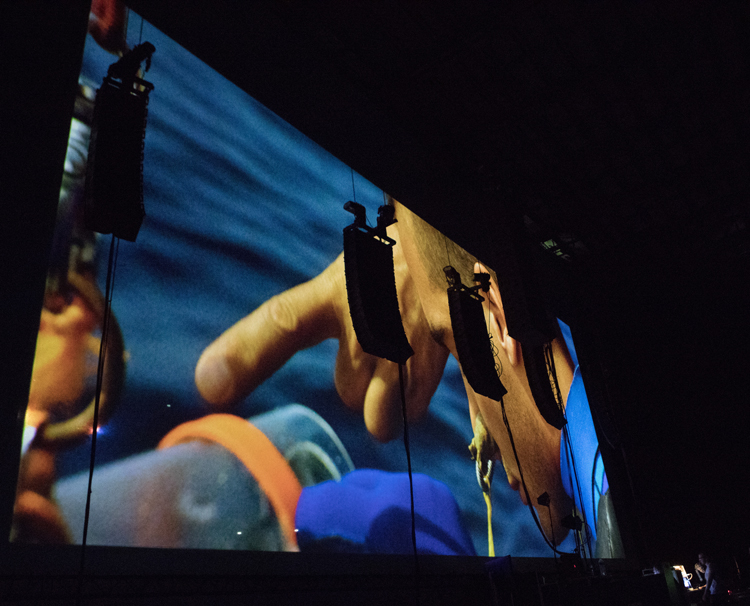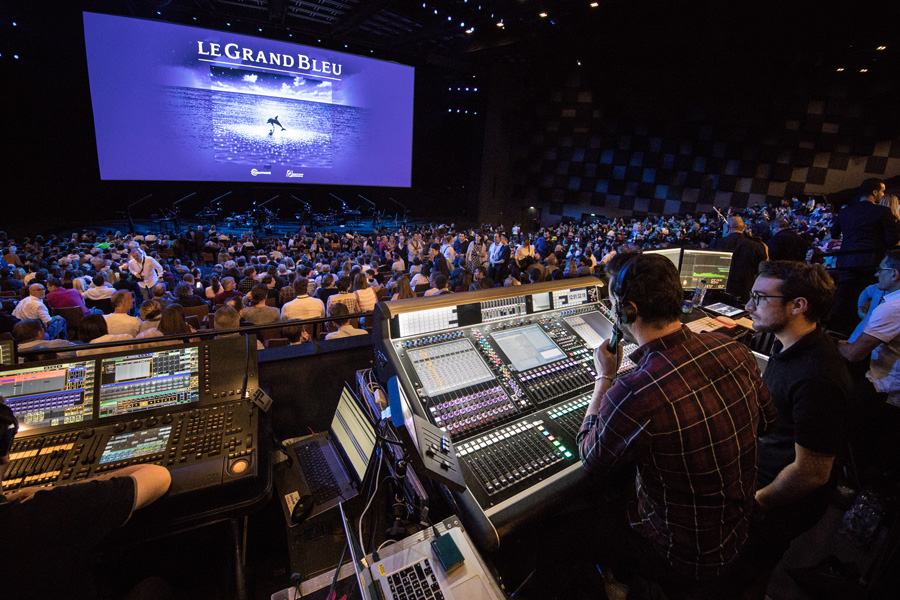
May 11th. Everything’s in place. Long months of thorough work are leading to The Big Blue in Live version. One of the essential shadow men, Jean-Phi Schevingt, shares with us his passion for this project. Add the L-Isa full configuration and our listening impressions and you’re ready for a No Limit dive! Let’s go.
Jean-Philippe Schevingt, the goldsmith of sound
SLU : How did you come to join this team?
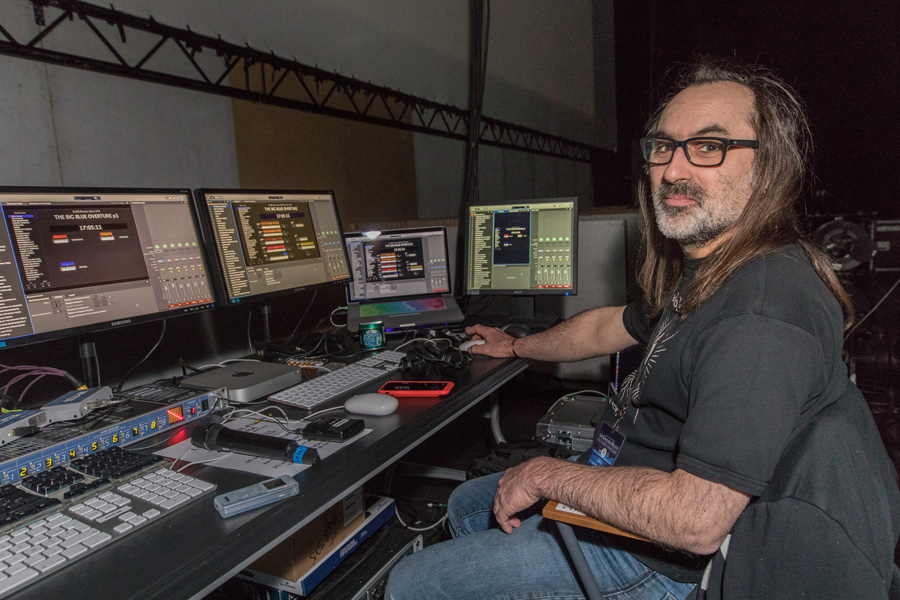
Jean-Philippe Schevingt : Most simply, I was called by Romain who quickly understood that it would take two to find and rework this amount of sound data.
I started working on the first patches in January when I was able to get my hands on all the machines, and I saw how long it was taking.
I myself quickly understood that until the last moment I was going to be occupied by this task and that I would never have found the time to work on my scores.
SLU : Tu devais aussi jouer ?
Jean-Philippe Schevingt : Of course, we should also have been the two keyboard players of the orchestra with Romain but I preferred to call Eric to tell him that it was better that I remain at the disposal of the musicians in order to put them in the best conditions to play.
As in addition, as I was the one who programmed everything, even in terms of assignments of sounds to the different MIDI controllers, it was better that I stick to do that. And then, to play this soundtrack you have to know how to stick perfectly to the score and the click track, by placing the note on the fourth sixteenth note of a time, and I’m not good enough reader to do that (laughs)
SLU : It seems that Eric Serra (the composer, Ed.) keeps everything!
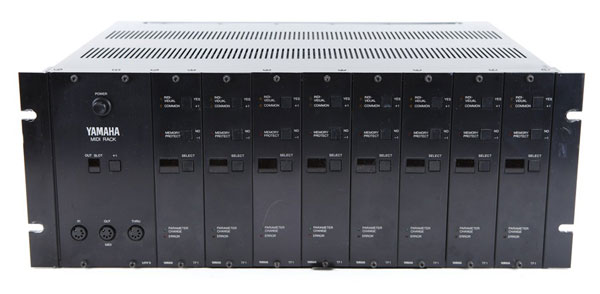
Jean-Philippe Schevingt : Lucky enough! He preciously kept all the Sysex files and the backups of his synths, I was able to have elements, but to read them it was necessary to refurbish old Macs with old OS to manage to use the old software of 1988 and the Sysex of TX816 (Racks containing eight FM synthesis cards, Ed.).
Thanks to that, I was able to program virtual FM8s from Native Instruments. You should know that 80 to 90% of the Big Blue synth sounds come from the Yamaha DX7 with a lot of layering. Hats off anyway to MOTU for their backward compatibility.
I have never seen this. I don’t know any software that knows how to open a session that is 30 years old. Neither ProTools, nor Cubase… Look at the date of the last modification of the opening credits. February 9, 1988. You double click and after being told that the software does not find Eric’s MIDI environment …
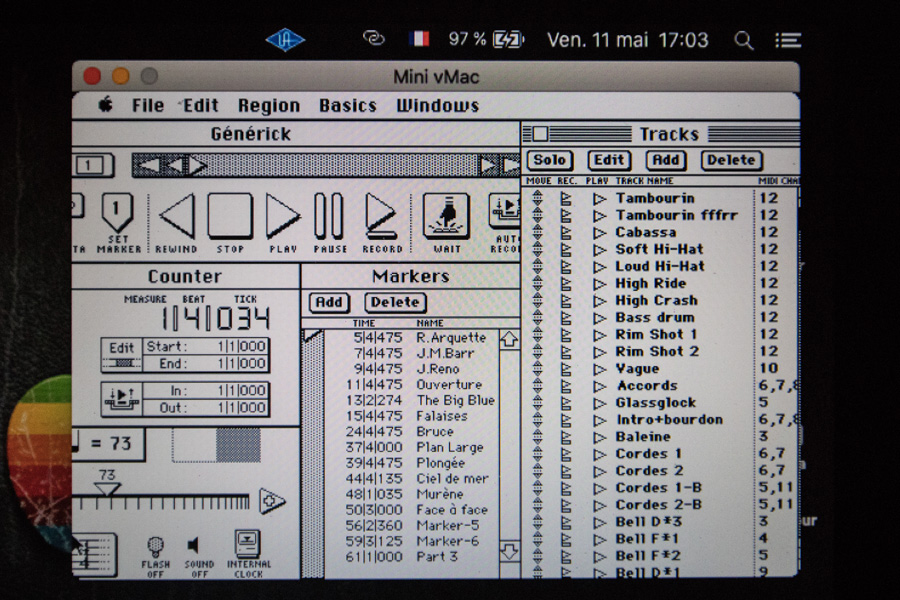
SLU : Et en dehors de Yamaha ?
Jean-Philippe Schevingt : We had to take sounds from the Emulator 2, the Akai S 950, the Kurzweil 1000 PX or the Roland MT32. Once sampled, all of these samples and virtual synths are managed by Apple’s MainStage host software. Two double redundant configurations. A first one contains all the sounds that will be played by the two keyboard players, by Eric and by the sax which also has a keyboard.
The second one contains all the drum and percussion sounds but also all the samples that will be played by the two drummers. The whole set up fits on 4 Mac Mini, big quad-core models with a lot of RAM. Add to that some MADI cards and I’m able to deliver to FOH the 64 outputs they asked me for: 32 for keyboard sounds and 32 for drum sounds.
SLU : You were mentioning redundancy…
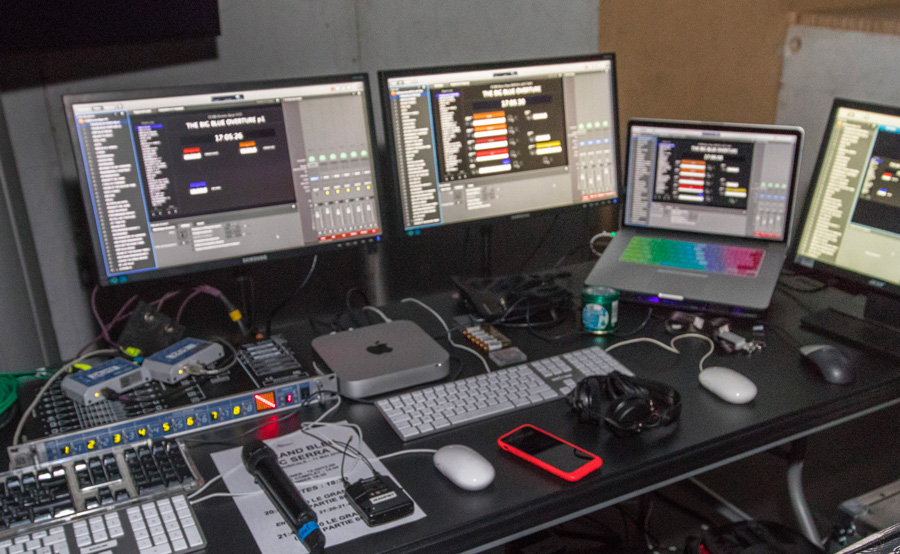
Jean-Philippe Schevingt : Everything is mirrored and ends up in a RME MadiBridge that I have right in front of me. If the main one ever creates a problem for me or generates a noise, I switch to the spare one.
SLU : Are you sync to the Time Code too?
Jean-Philippe Schevingt : No it’s all done manually, I don’t have the need to be hooked to it. There was a point when I might have needed a MIDI clock to follow the tempo of toms with a delay played by Eric, but not for the rest.
SLU : MIDI stands up firmly despite its 35 years of age…
Jean-Philippe Schevingt : On long cable lengths like we have here, it is still the most reliable. 15 meters without amplifier, converter nor expander, nothing that could interrupt the signal. I am installed right where it is needed for that.
I had too many problems with USB, especially when you have a lot of machines and where an IP conflict causes you to lose a keyboard or a pad. I have my 14 MIDI cables coming from the different controllers on stage to two MIO Connectivity interface racks which send the orders to my two MainStage.
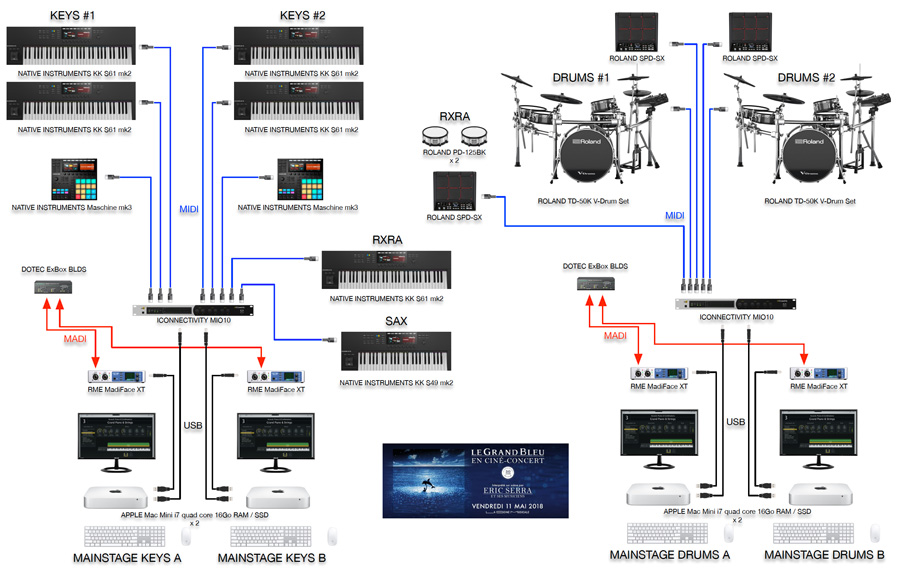
SLU : So tonight it’s gonna be Next, Next, Next (smiles)
Jean-Philippe Schevingt : Exactly, but I also monitor the progress of things because the boys are so busy with their two hands and feet that sometimes it’s me who brings them layers or remotely puts their pedal down so that the sound really comes from far (laughs). They are real professionals, but they have so much to do …
I’ve been on it all day and 6 days a week since February 23rd, I’ve only done that, I know what I’m talking about! I also made a technical rider with the time cues. Whether to reboot or move something, I know when to do it.

SLU : This might sound like a silly question here, your configuration works perfectly at the moment we are talking (the morning of the concert day, Ed.). You won’t touch anything anymore from now on, or will you restart the whole before the show tonight?
Jean-Philippe Schevingt : I’m going to turn everything off, let it cool down and, one hour before the show, I’m going to restart everything and take a tour of all my keyboards. And I will test my spare set up too.
SLU : It could be tempting, though…
Jean-Philippe Schevingt : Some guys never touch anything and it can work that way, but IT can reserve some weird surprises. A computer will stock material into its RAM modules, and when you switch it back on again, if it doesn’t empty its buffers correctly, it will block part of its RAM and might work in an awkward way.
SLU : MainStage and you…
Jean-Philippe Schevingt : It’s an old story. I set out on the road the first tour for Calogero (French singer) with in 2007. I went to Ireland to get the first Logic Studio box ever delivered there. Two years later, with Ivan Cassar (French composer, arranger, producer and piano player), we set up the first full virtual show in the world in stadiums for Mylène Farmer (French singer). As everything was virtual, we had equipped 6 Mac Pros with 8-core, 4 internal disks, we had consolidated everything (We are at the level of aviation industry redundancy, Ed.).
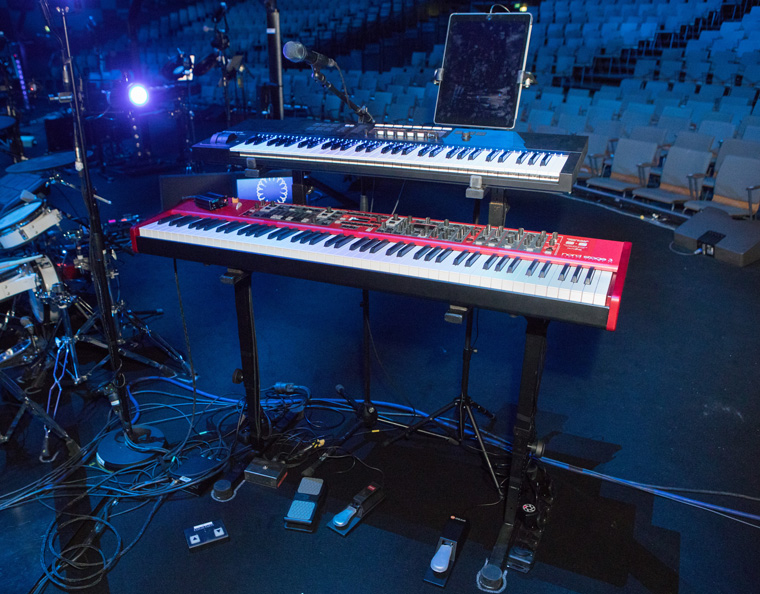
To make you understand the power of MainStage, for The Big Blue and to be relaxed, we should have found around 20 DX7s and at least 6 fully fledged samplers.
The choice is quickly made. We compared, in Eric’s studio, the sound output from the rack TX816 and FM8 plugs and it is the latter that win, thanks also to more modern converters.
Their ease of use allowed us to very easily reconstruct the layering with the slight tone shift used on the 1988 version.
SLU : How drum sounds are made?
Jean-Philippe Schevingt : With Native Instruments Battery 4. I also use on stage master keyboards, Complete Control from Native.

SLU : I see red gear everywhere, though…
Jean-Philippe Schevingt : (smiles) These are Nord Stage, because the 88 notes model from Native (also with heavy response keys), has no pitch bend, and our musicians use this all the time, for example for Pan flutes.
It’s a shame because the next model that will be released soon has knobs. It’s no good luck. They had made the choice at Native to replace them with ribbons like the “Touch Bar” of the Mac, but that did not work with the musicians because it is pretty, it is modern, it is fun but …
SLU : Can you get these melodies out of your head…
Jean-Philippe Schevingt : No I can’t (smiles). I have been living with them day and night for several months. I will happily dive into Eddy Mitchell’s tour next week (French singer). That said, I love this soundtrack, and as I said to Eric, after seeing the movie in cinemas when it came out and discovering sync to music on screen, a sync such as even uninitiated people notice it, that contributed a lot to my desire to do music computing.
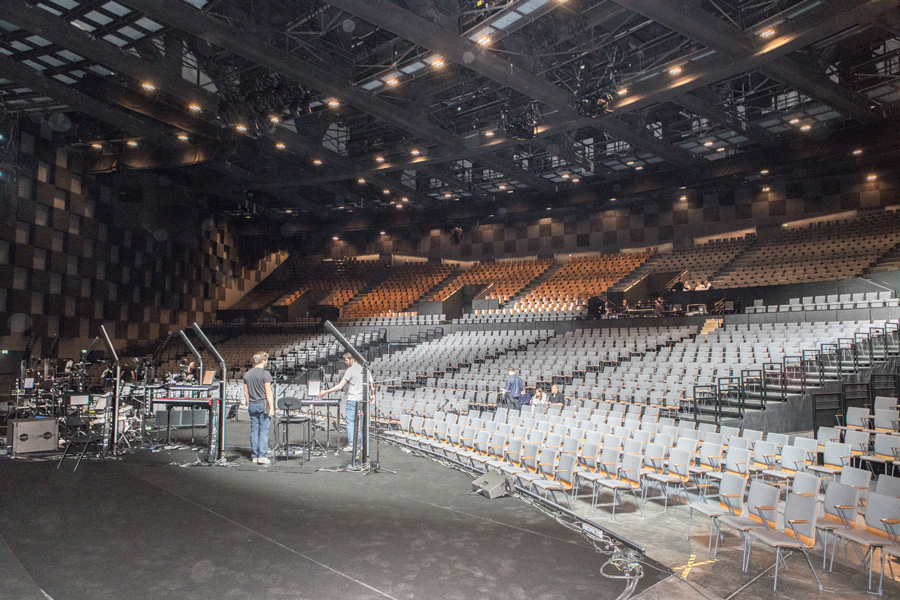
In the months after the screening, I bought my first sequencer, my first computer, my first machines, and started programming. So it’s funny to find myself 30 years later in this position and to have the chance to introduce him to current toys.
SLU : This soundtrack doesn‘t seem easy to play…
Jean-Philippe Schevingt : For us and the musicians it is complicated because in a song, Eric is able to repeatedly change the tempo and the number of beats in the measures to catch up with the image. Musically this is not that obvious, but to play on stage is really not easy.
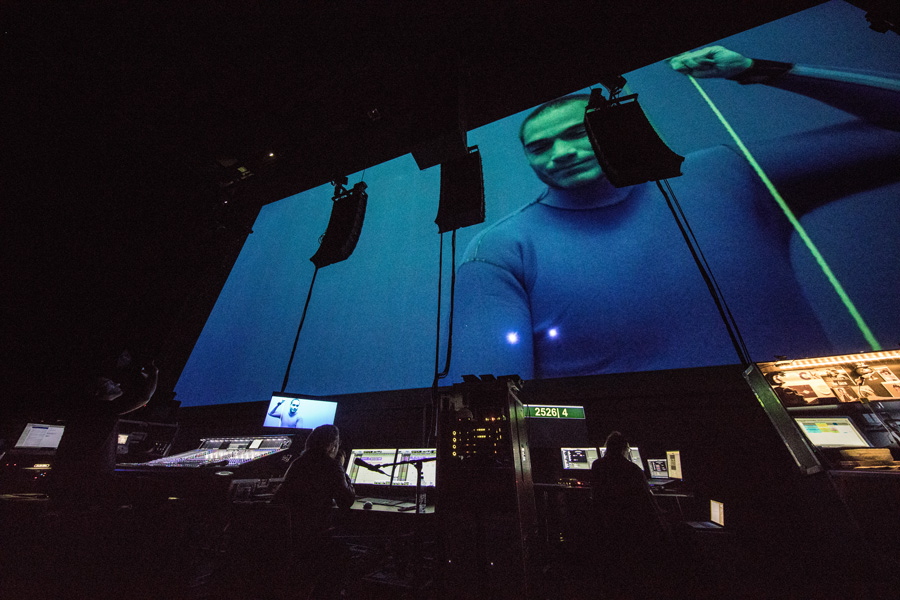
SLU : Too bad you’re hidden behind a curtain with Romain…
Jean-Philippe Schevingt : But we should have been in front, Eric wanted it and until two or three days ago, we should have accompanied the musicians with our gizmo kit.
But you have to be able to act calmly when the need arises, without attracting people’s attention because we go around the desk and tinker with something.
I am frequently on stage as a keyboard player with the responsibility sometimes of a ProTools, and my obsession is to stay clean in front of people, to react without being noticed.
May 11th
For the first time, we enter the Grande Seine and as always behind the scenes. The huge micro-perforated screen makes it possible to follow the film which now takes place at the same time as the musicians rehearse, but upside down. Seeing Rosanna Arquette with a head 3 meters high let see the magnificent green of her eyes… but let’s move on.
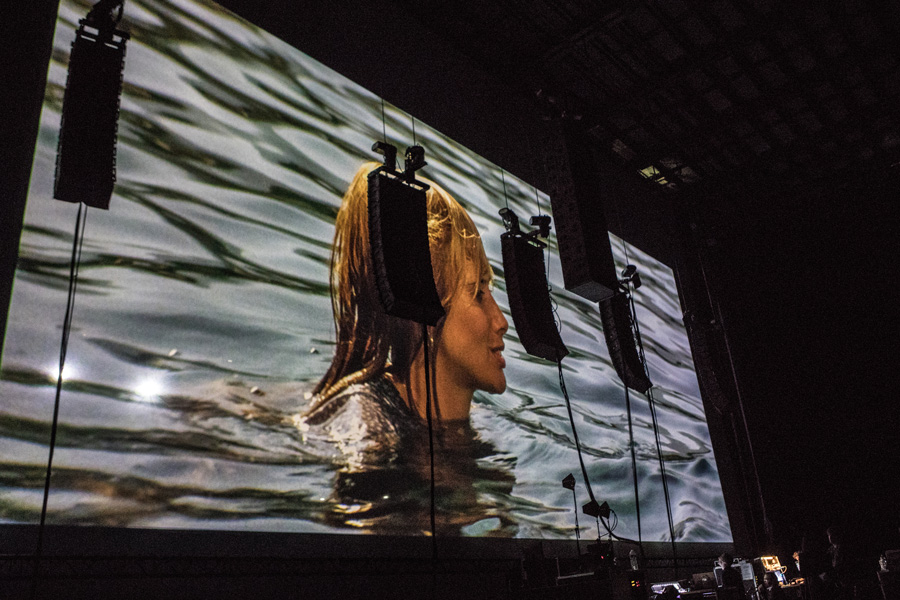
The Focus deployment by L-Isa is also a pleasure to see and mainly to listen to. There are diaphragms and drivers indeed, and with K2 we are in 3-way on the three central points, the 3-4-5, with 9 enclosures per array. When there is space, this Focus configuration seems to be the perfect solution to build muscle in the center where naturally there are sources rich in bass and dynamics. Another advantage, these three lines of K2 being very close to the subwoofers column, the connection works well.
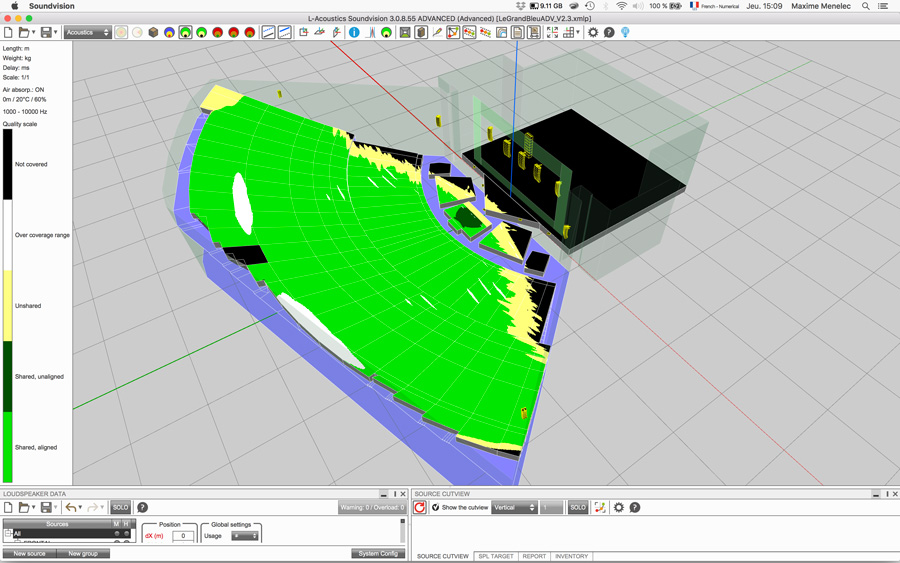
Lines 2 and 6, always behind the screen and of 12 boxes each, remain in Kara just like the 1 and 7, of 9 elements each, visible this time by the public because hung on the widest part of the room and twisted inside.
The surrounds, made up of two lines of 9 Kiva II, are placed at the top of the stands in the distance. At the end of the stage, 6 Kiva II pull the image down and give a little sound to the front rows.
When you listen, you immediately notice that the stage volume and the screen trap the infra bass frequencies and that the K2’s treble drivers are playing with the screen. It bounces in a dry way. At the bottom of the screen, hidden by a black hanger that surrounds it, we find Ben Rico and his console, Romain Berguin and his ProTools, Jean-Philippe Schevingt and his half computer and half synth machines, accompanied by the backliner in charge of the acoustic instruments and of the technician in charge of the video server. Add to this a big pack of LA12X controllers (and only 12X), even for Kara or Kiva. Hats off to Dushow, the rental company.
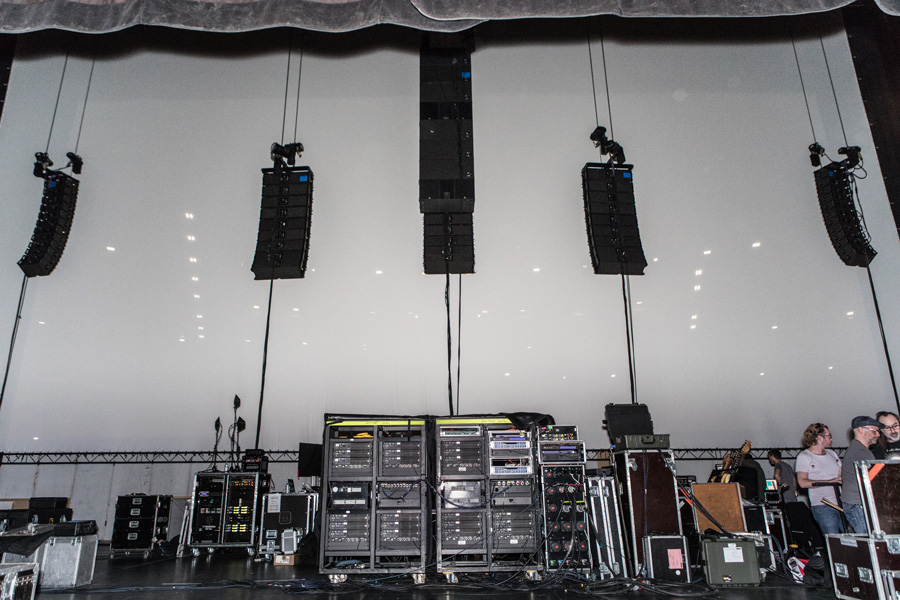
With the hall still empty, the sound is naturally a little dull on the last octave, while the bass and infrabass, although present and precise, are a bit long. Other details would also call for a comment, but as with a full room and thanks to Max and Seb, they will disappear almost entirely, no need to waste bits.
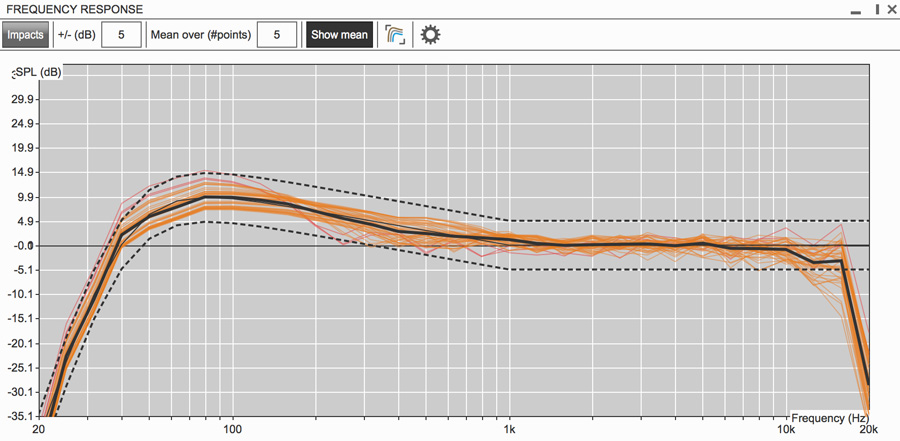
On the good news side, the bass gives chills because it makes you rediscover the soundtrack. The kick drum, Eric’s bass, the synth layers, and some notes that get infra-infra in 40 Hz, bring a natural and a base that the poor serious freeze-dried and dripping usual bass response from a standard cinema cannot reach… The rehearsal runs smoothly at 90 dB(A), a perfect level which will only very rarely be exceeded the same evening.

Seb had to rework his spatialization as planned, especially the extends which are not behind the screen and cannot be easily transposed into the room.
The low end of the spectrum, which cannot sound the same way between a small studio and a large room, is also set rightly with a level of reverberation adjusted to that of the Grande Seine.
The end result is as beautiful as a glossy Marcoussis (Home town of L-Acoustics, Ed.) brochure.
Noir salle
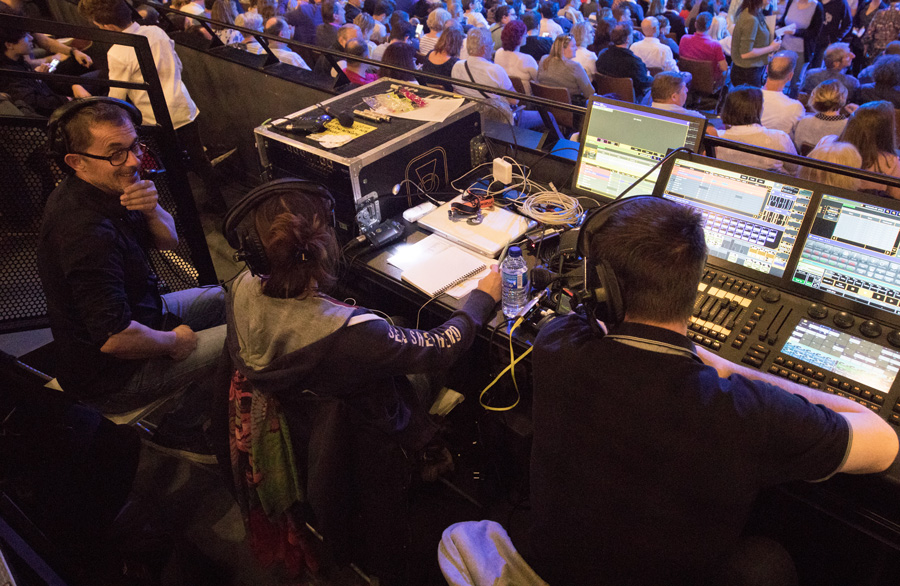
The musicians step on stage and grab their instrument, Eric Serra arrives to the applause of an audience obviously already under the spell.
The discreet lights, but how could it have been otherwise not to pollute the screen, bring their own atmosphere.
It was the ultimate difficult lighting project here, but LD Dimitri Vassiliu came out of it with his usual sheer elegance and experience.
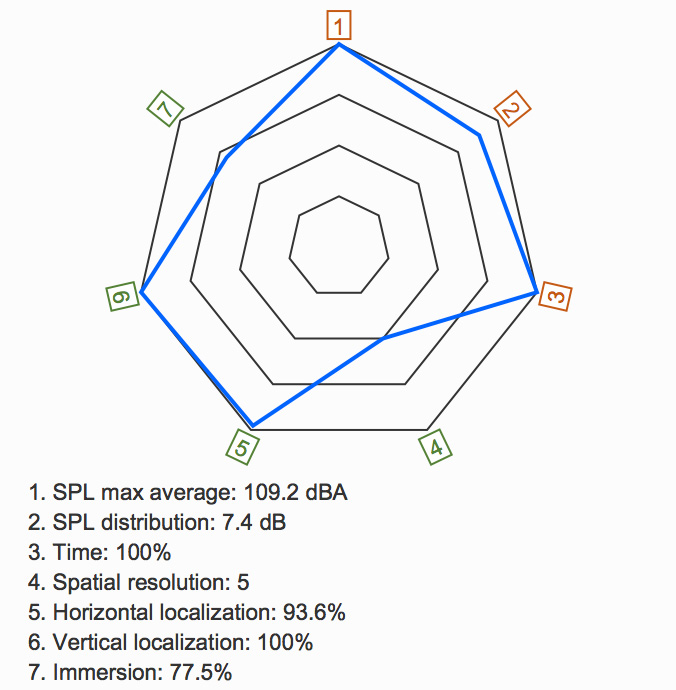
The 7 musicians come to life at once, guided by an invisible half-ProTools half-Berguin conductor and the magic works instantly. Implacable.
The credits scroll and we are all taken by the same pinch. The Big Blue comes back to life before our eyes and especially in our ears but better, so much better than in a standard cinema.
The sound image overflows widely from the screen and saturates our poor stereophonic spirit, soon stereophobic, with happiness.
The magnitude, the precision, the breadth of the spectrum, the dynamics, the beauty and the localization of the sounds, everything contribute to dress up the image, and this soundtrack which has already done so much for the movie, steels the show for the first time for itself.
The musicians’ play with their own timing, the new quality of the sounds, the mix reworked for Seb’s room, the far from obvious settings of Max, Ben’s “catering service”, the power at the top of K2 which has finished to perforate the screen, L-Isa who with the Focus deployment is finally ready to tackle the variety and the shadow work so important of Romain and Jean-Philippe, all these make this movie-concert a real concert-movie and above all, a rare moment when my eyes sometimes had a strange lacrimal reaction. I must be allergic to good sound and talent ;-).
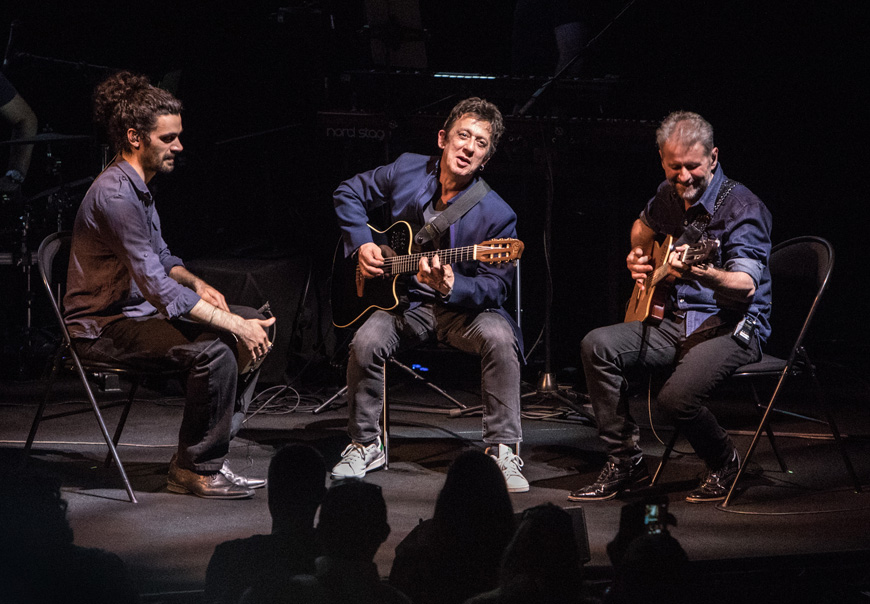
A few months before the entry into force of the “102 dB(A) limit” French Decree, we enjoyed 90 dB(A) and 101 to 104 dB(C) remarkably well achieved, without ever wincing or putting ear-plugs, but with the breadth and impact essential to any show. Wondering what the extra 15 dB is for.
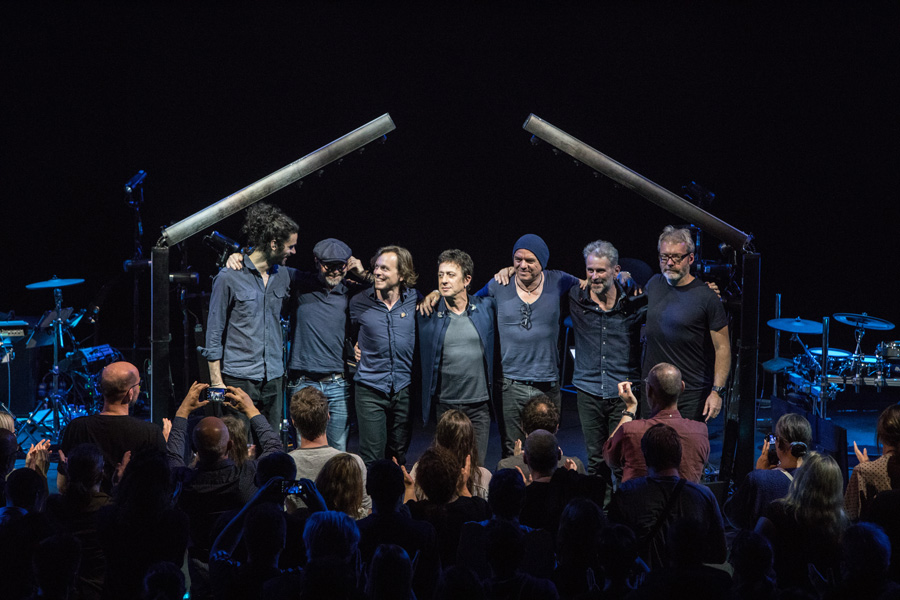
The teams
Le Son
FOH sound: Sébastien Barbato (ENKP company ) / Maxime Menelec (Upoint company)
Monitors sound: Benjamin Rico / Pierre Veysset
Backline: Jean-Phi Schevingt / Lucien Viendras
Protools: Romain Berguin (Société upoint)
L-Acoustics support: Fred Bailly / Florent Bernard / Guillaume Le Nost
Installation team, Dushow Diffusion: Max Maguet / Antoine Dumortier / Théophile Thomassin
The Musicians:
Eric Serra: Bass, Keyboards, Electronic percussions, Guitar,
Loïc Pontieux: Electronic Drums,
David Salkin: Electronic Drums,
Sébastien Cortella: Keyboards,
Julien Carton : Keyboards,
François Delfin: Guitar,
Renan Richard: Saxophone, Keyboards, Percussions
Lights:
Lights: Dimitri Vassiliu / Philippe Marty / Soline Marchand
Dushow project managers: Regis Nguyen / Adrien Pratz / Alex Capponi
Live Production: Jean-François Bellino / Mathieu Drouot / Sylvain Gilbert / Cyril Sebbon
Sound Creation:
Creation of the sound played by the musicians, reverberations and files restoration: Jean-Phi Schevingt, Romain Berguin et Eric Serra.



